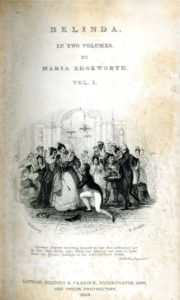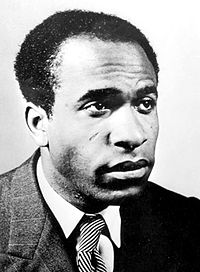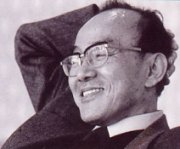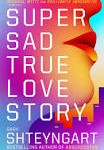by JULIÁN JIMÉNEZ HEFFERNAN
The essay begins:
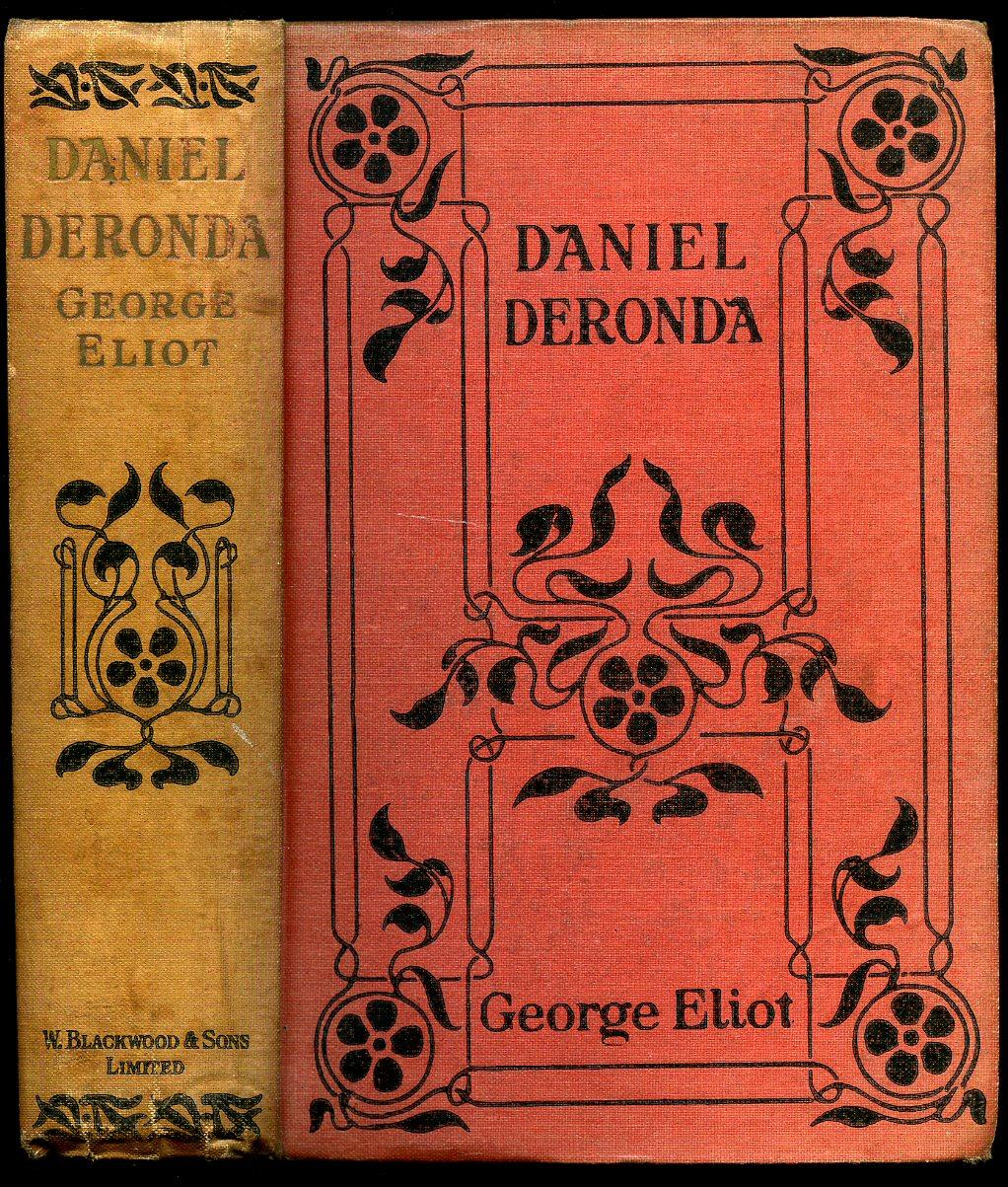 In chapter 40 of George Eliot’s Daniel Deronda we learn that the title character’s “more exquisite” quality lies in his “keenly perceptive sympathetic emotiveness,” his “profound sensibility to a cry from the depths of another.” Earlier on, Deronda is said to have “the stamp of rarity in a subdued fervor of sympathy, an activity of imagination on behalf of others” (178). This is not a casual trope. Deronda is extolled for being “receptive instead of superciliously prejudging,” and “receptiveness” is described as “a rare and massive power” (492). The terms rare and rarity recur in the novel, denoting what is very uncommon or unusually fine. As a modifier, rare is almost invariably paired with the nouns of Jewish singularity—moral “receptiveness” (496), vocal-physiognomic “perfection,” verbal “quality” (809), and “visionary excitement” (513). By the time Gwendolen realizes that her feelings have turned Daniel “into a sort of trust less rare than the fidelity that guards it” (430), the suggestion that moral redemption presupposes rarity is simply overbearing. The rationale of the polysemy is catachrestic because scarcity connotes value. The rare item is precious because its limited currency eludes the wider circulation of commodified objects and persons in liberal-capitalist society:
In chapter 40 of George Eliot’s Daniel Deronda we learn that the title character’s “more exquisite” quality lies in his “keenly perceptive sympathetic emotiveness,” his “profound sensibility to a cry from the depths of another.” Earlier on, Deronda is said to have “the stamp of rarity in a subdued fervor of sympathy, an activity of imagination on behalf of others” (178). This is not a casual trope. Deronda is extolled for being “receptive instead of superciliously prejudging,” and “receptiveness” is described as “a rare and massive power” (492). The terms rare and rarity recur in the novel, denoting what is very uncommon or unusually fine. As a modifier, rare is almost invariably paired with the nouns of Jewish singularity—moral “receptiveness” (496), vocal-physiognomic “perfection,” verbal “quality” (809), and “visionary excitement” (513). By the time Gwendolen realizes that her feelings have turned Daniel “into a sort of trust less rare than the fidelity that guards it” (430), the suggestion that moral redemption presupposes rarity is simply overbearing. The rationale of the polysemy is catachrestic because scarcity connotes value. The rare item is precious because its limited currency eludes the wider circulation of commodified objects and persons in liberal-capitalist society:
To save an unhappy Jewess from drowning herself, would not have seemed a startling variation among police reports; but to discover in her so rare a creature as Mirah, was an exceptional event which might well bring exceptional consequences. (378; emphasis mine)
Like the jewels bartered back and forth by the novel’s characters (Gwendolen, the pawnbroker, Daniel, Grandcourt, Lydia), something rare is valuable because it is ontologically unlikely: its ancestrality attests to the value of survival, and its exposure to the risk of extinction folds back on the value. However temporarily coopted by wider trade orbits, the jewels remain an intractable, inassimilable surplus. And so do Deronda’s Jews, always on the brink of an excessive, sacrificial, and sublime self-waste. Even the renegade Baruch Spinoza got “his crust by a quiet handicraft” (472) in lens-grinding before completing his Ethics. The jewels: the Jews: their stamp of rarity.
The contention that “receptiveness is a rare . . . power” involves a twofold implication: first, that receptiveness is a power, and second, that receptiveness is rare. Mesmerized by the range of hermeneutic possibility that the concept of sympathy affords, Eliot’s critics have addressed the former implication while neglecting the latter. Predictably, then, the response to Daniel Deronda has been spellbound by the shine of a familiar faculty (moral sympathy) that, because in principle unrare in Eliot’s narrative world, seems in little need of special examination. Indeed, the near scientific symmetries of a plot conceivably modeled upon the Goethean allegoresis of elective affinities reinforce the impression that everything in the story depends on moral relatedness. On the one hand we have the English characters, with the rich Grandcourt at the extreme of emotional stolidity. Then comes Gwendolen Harleth, an ungenerous dweller in “the border-territory of rank” (Deronda, 23) who marries Grandcourt to allay social anxiety. This doesn’t prevent her from cultivating an interest in Daniel, the character that occupies the novel’s central position. Daniel enjoys the best of both worlds: groomed impeccably as an English gentleman, he can also boast of “the keenly perceptive sympathetic emotiveness” that, in the novel’s logic, belongs to the Jews. Because, it turns out, he is also a Jew. On the other hand we have Mirah and Mordecai—Deronda’s Jews—which I designate as such to distinguish them from the common, money-minded, shop-keeping Hebrews also present in a novel where, let me recall, “there are Ezras and Ezras” (567). Mordecai is placed at the extreme, in figurative opposition to Grandcourt, whom he never meets. He is a concentrated, unproductive version of Jewish rarity: the passionate man who sacrifices his life to dig up the historical grounds of his people’s moral superiority. Grandcourt and Mordecai are both unrealistic, near Dickensian characters who belong in the world of romance (if not romantic farce): significantly, both die before the tale comes to a close. Between Mordecai and Deronda stands Mirah, Mordecai’s sister, a destitute Jewish girl, in a position of structural equivalence to Gwendolen. Like the English girl, she is saved by Deronda and falls in love with him. Unlike Gwendolen, she becomes the object of Deronda’s favor. The end of the novel describes their wedding and trip to Palestine to start a new life devoted to the construction of the nation of Israel.
The value of the central characters (Gwendolen, Daniel) is a measure of their ability to relate to characters standing—or seeming to stand—across the Gentile-Jew divide. Understandably, critics have been less interested in the dynamics of that ability than in the origin and function of Eliot’s sympathy toward the Jews. This sympathy most critics take for granted. I argue, however, that the overdetermined specificity of the cultural-ethnic division dramatized in Deronda forces Eliot to depart from the more generic-universal treatment of moral sympathy at work in her other narratives. And she certainly knows it: “Nothing is here narrated of human nature generally” (Deronda, 91). It forces her to realize, somewhere in her narrative unconscious, that sympathy is a passion not exclusively based on receptivity (the ability to receive the other), since it also depends on the givenness of the other. And her novel, I contend, construes the Jew as a poorly given, if not ungiven, alterity. The reason for Jewish ungivenness is rarity, a quality that stands in direct proportion to receptivity within the group: the higher your receptivity to those of your group (race, nation), the less chance you have of being received—even by the people inside the group whom you are most willing to receive. The “unpleasant” grabbing of Deronda’s arm, an action performed twice, first by the white-bearded Joseph Kalonymos in the Frankfort synagogue (368) and second by the consumptive Mordecai in the secondhand bookshop (387), testifies to the dilemma of ethnical-cultural asynchronicity and moral interruption that my article sets out to explore. The fact that rarity is bound up thematically and rhetorically with the parallel notions of ancestrality and extinction calls for biological considerations that Eliot may have discovered, as I will argue, in Charles Darwin. But insofar as these notions (ancestrality and extinction) map out a deep time without human time, Eliot’s depiction of Jewish rarity in Deronda raises the kind of metaphysical challenge that Immanuel Kant aimed to meet in his first Critique: What is the ontological status of nonhuman time? And what kind of epistemic (narrative, rhetorical) processing does it demand?
My attention to the rhetorical effects of this thematic focus on rarity may result in a corrective to standard accounts of George Eliot’s philo-Semitism. Although this is not the primary goal of my article, I do not disown it as a hermeneutic corollary. The fact that readers with a stake in Eliot’s philo-Semitism unfailingly overlook the existence of deconstructive approaches to the novel shows that disregard for the novel’s complex rhetorical texture can foster belief in versions of Eliot as a utopian ideologue, a champion of either proto-Zionism or cosmopolitanism. My interpretation, by contrast, draws on extant deconstructive and rhetorically focused readings of Daniel Deronda by critics such as Cynthia Chase, Catherine Gallagher, and Ian Duncan and yet seeks to reach beyond them by putting into play the metaphysical question of time that instigates the rhetorical-narrative processing of temporality.
When Deronda’s friend Hans Meyrick boasts that “there is really little difference between me and—Maimonides” (642) he is wrong in ways that go beyond—and against—his intended irony. In the novel’s moral-lexical economy, difference-making rarity is the exclusive property of the Jewish people. But they pay a great price for this distinction. They reach the present from an immemorial past—David Kaufmann has stressed “the enigma of their marvelous preservation”—and have limited hope of reaching the future. Compared to some of the substantial English people dwelling in the novel’s present, they seem hardly real. The figural etymology of rare underpins this unreality. Since the mid-fifteenth century, the adjective rare has meant both “unusual” and “thin, airy, porous.” The more specific implication of rare as “few in number and widely separated, sparsely distributed, seldom found,” can be traced back, via Old French rere (“sparse”), to the Latin rarus, meaning “thinly sown, having a loose texture; not thick; having intervals between.” Thus Jewishness and rarity concur in a shared implication of dissemination or diaspora. Thinly sown, airy, and scattered, Deronda’s Jews are inexorably disembedded, whence their paradoxical status as archaic ultramoderns. They roam the narrative as dialectical images of an Urgeschichte (prehistory) whose discrepancy in and for the present might harbor a utopian future. Alienated from the English community, they also risk losing touch with their related particulars: Deronda nearly missing Mirah, Deronda on the verge of discounting Mordecai, Mirah close to overlooking her family, Deronda, of course, forgone by his mother. The existence of these singularities is, moreover, steadily encircled by a void. If their future is dizzily open, their past is a riddle and a mire. Daniel, described at one point as a “yearning disembodied spirit” (365), ignores his origins; Mirah flees from them and attempts suicide; Mordecai tumbles into them and dies. Remote and obscure like Mordecai, elusive and unfocused like Daniel, fragile and fugitive like Mirah, these Jews cherish nonetheless a gift—a rare talent—of moral receptiveness that is at odds with the utilitarian lifestyle of most of the English. Hence the paradox: the differential aspect (the stamp of rarity) that deepens their unrelation—with the English, at least—is precisely their ability to relate, their extraordinary receptivity. This doesn’t mean that the problem is an English incapacity to receive them. In the novel this is less a problem than a fact. The problem—and Eliot makes it very clear that there is a problem—lies with the Jews, who cannot be received because, however fit to receive others, they themselves posit an unacceptable otherness. Though explicitly perspectivized through English prejudice—Deronda’s, the Meyrick women’s—the first forthright depiction in the novel of a Jewish person (Mirah) answers no other purpose than to uphold the racist preconception, denounced by Kaufmann, of the Jews as “a peculiar people.” Recall that, in its extended meaning, rare also means anomalous. Or that no English character wishes to keep the diamonds: the jewels end up “scattered around [Gwendolen] on the floor” (359). Just like the Jews at the end, shipped toward the uncertain. The jewels: the Jews: their stamp of diaspora. Continue reading …
There are patterns of continuité discontinu (Derrida) in the figural transactions between human groups and between humans and animals in George Eliot’sDaniel Deronda that remain underexamined. By emphasizing ironic incommensurability and difference, this essay seeks to reveal the logic of ungivenness organizing human interactions in a novel haunted by images of deep time and species extermination. Eliot’s interest in ancestrality and extinction was fueled by her readings in geology and biology (Darwin), but it also evinces a metaphysical concern with uncorrelated time (Kant) that is inseparable from her fascination with the idea of moral rarity.
JULIÁN JIMÉNEZ HEFFERNAN is Professor of English and Comparative Literature at the University of Córdoba, Spain. He is the co-editor (with Paula Martín Salván and Gerardo Rodríguez Salas) of the volume Community in Twentieth-Century Fiction and publishes on Victorian literature, modern fiction, narrative theory, and deconstruction.
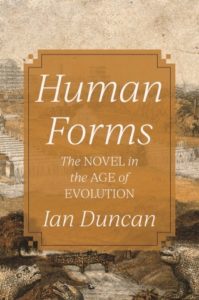 Human Forms
Human Forms Ian Duncan is professor and Florence Green Bixby Chair in English at the University of California, Berkeley, and a member of the Representations editorial board. His books include Scott’s Shadow: The Novel in Romantic Edinburgh (Princeton).
Ian Duncan is professor and Florence Green Bixby Chair in English at the University of California, Berkeley, and a member of the Representations editorial board. His books include Scott’s Shadow: The Novel in Romantic Edinburgh (Princeton).
 In chapter 40 of George Eliot’s Daniel Deronda we learn that the title character’s “more exquisite” quality lies in his “keenly perceptive sympathetic emotiveness,” his “profound sensibility to a cry from the depths of another.” Earlier on, Deronda is said to have “the stamp of rarity in a subdued fervor of sympathy, an activity of imagination on behalf of others” (178). This is not a casual trope. Deronda is extolled for being “receptive instead of superciliously prejudging,” and “receptiveness” is described as “a rare and massive power” (492). The terms rare and rarity recur in the novel, denoting what is very uncommon or unusually fine. As a modifier, rare is almost invariably paired with the nouns of Jewish singularity—moral “receptiveness” (496), vocal-physiognomic “perfection,” verbal “quality” (809), and “visionary excitement” (513). By the time Gwendolen realizes that her feelings have turned Daniel “into a sort of trust less rare than the fidelity that guards it” (430), the suggestion that moral redemption presupposes rarity is simply overbearing. The rationale of the polysemy is catachrestic because scarcity connotes value. The rare item is precious because its limited currency eludes the wider circulation of commodified objects and persons in liberal-capitalist society:
In chapter 40 of George Eliot’s Daniel Deronda we learn that the title character’s “more exquisite” quality lies in his “keenly perceptive sympathetic emotiveness,” his “profound sensibility to a cry from the depths of another.” Earlier on, Deronda is said to have “the stamp of rarity in a subdued fervor of sympathy, an activity of imagination on behalf of others” (178). This is not a casual trope. Deronda is extolled for being “receptive instead of superciliously prejudging,” and “receptiveness” is described as “a rare and massive power” (492). The terms rare and rarity recur in the novel, denoting what is very uncommon or unusually fine. As a modifier, rare is almost invariably paired with the nouns of Jewish singularity—moral “receptiveness” (496), vocal-physiognomic “perfection,” verbal “quality” (809), and “visionary excitement” (513). By the time Gwendolen realizes that her feelings have turned Daniel “into a sort of trust less rare than the fidelity that guards it” (430), the suggestion that moral redemption presupposes rarity is simply overbearing. The rationale of the polysemy is catachrestic because scarcity connotes value. The rare item is precious because its limited currency eludes the wider circulation of commodified objects and persons in liberal-capitalist society: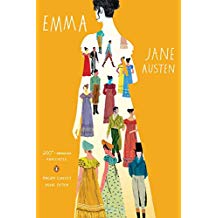 It is at least ironic that the characters and narration of Jane Austen’s Emma articulate excessively their preference for verbal and temporal economy. Clever Emma, who admires Mr. Martin’s proposal letter to Harriet for being “strong and concise; not diffuse,” observes later that charades “in general cannot be too short.” And at the end of dinner at Randalls, “while the others were variously urging and recommending, Mr. Knightley and Emma settled it in a few brief sentences” (122). It might surprise us that at the novel’s turning point, “a few minutes were sufficient for making [Emma] acquainted with her heart” (382), were it not the case that by this time, we have already heard the phrase “half a minute” ten times.
It is at least ironic that the characters and narration of Jane Austen’s Emma articulate excessively their preference for verbal and temporal economy. Clever Emma, who admires Mr. Martin’s proposal letter to Harriet for being “strong and concise; not diffuse,” observes later that charades “in general cannot be too short.” And at the end of dinner at Randalls, “while the others were variously urging and recommending, Mr. Knightley and Emma settled it in a few brief sentences” (122). It might surprise us that at the novel’s turning point, “a few minutes were sufficient for making [Emma] acquainted with her heart” (382), were it not the case that by this time, we have already heard the phrase “half a minute” ten times. TRISHA URMI BANERJEE
TRISHA URMI BANERJEE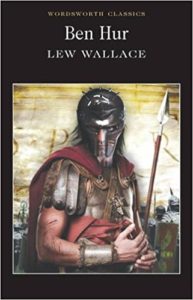 One curious feature of nineteenth-century British and American novels about Jesus is the fact that their central figure often remains largely offstage. In Harriet Martineau’s Traditions of Palestine (1830), William Ware’s Julian; or, Scenes in Judea (1841), Edwin A. Abbott’s Philochristus: Memoirs of a Disciple of the Lord (1878), Lew Wallace’s Ben-Hur: A Tale of the Christ (1880), James Freeman Clarke’s The Legend of Thomas Didymus: The Jewish Skeptic (1881), Marie Corelli’s Barabbas (1893), and Florence Morse Kingsley’s Titus, a Comrade of the Cross (1894), Jesus is pushed into the background while the narrative follows the life of a minor historical figure or the cultural milieu of first-century Palestine. Ware builds an elaborate character system out of various bit players from the canonical Gospels, turning Barabbas, the robber who is pardoned unwittingly in Jesus’s place, into Mary Magdalene’s ne’er-do-well brother and a proxy for her own narrative arc. Kingsley, beating Monty Python’s Life of Brian (1979) to the punch, forges a comic subplot out of the story of a cripple whom Jesus robs of employment: “Ha, fellow! thou didst heal me, three years ago, of the palsy, which had withered my limbs; and in so doing took away my living, for my begging no longer brought me money.” And behind all of this are elaborate historical backdrops drawn from both secular historiography and Holy Land tourist guidebooks.
One curious feature of nineteenth-century British and American novels about Jesus is the fact that their central figure often remains largely offstage. In Harriet Martineau’s Traditions of Palestine (1830), William Ware’s Julian; or, Scenes in Judea (1841), Edwin A. Abbott’s Philochristus: Memoirs of a Disciple of the Lord (1878), Lew Wallace’s Ben-Hur: A Tale of the Christ (1880), James Freeman Clarke’s The Legend of Thomas Didymus: The Jewish Skeptic (1881), Marie Corelli’s Barabbas (1893), and Florence Morse Kingsley’s Titus, a Comrade of the Cross (1894), Jesus is pushed into the background while the narrative follows the life of a minor historical figure or the cultural milieu of first-century Palestine. Ware builds an elaborate character system out of various bit players from the canonical Gospels, turning Barabbas, the robber who is pardoned unwittingly in Jesus’s place, into Mary Magdalene’s ne’er-do-well brother and a proxy for her own narrative arc. Kingsley, beating Monty Python’s Life of Brian (1979) to the punch, forges a comic subplot out of the story of a cripple whom Jesus robs of employment: “Ha, fellow! thou didst heal me, three years ago, of the palsy, which had withered my limbs; and in so doing took away my living, for my begging no longer brought me money.” And behind all of this are elaborate historical backdrops drawn from both secular historiography and Holy Land tourist guidebooks. SEBASTIAN LECOURT
SEBASTIAN LECOURT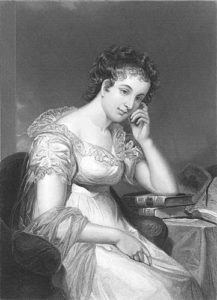 Maria Edgeworth (1767–1849) is famous for her bad plots. A contemporary reviewer of her 1814 novel Patronage complains that “the story is always the worst part of Miss Edgeworth’s novel.” There she consistently proves “inferior . . . to many of those that are vastly below her in everything else.” This backhanded compliment to a novelist publicly admired by Jane Austen and Sir Walter Scott may suggest some of the reasons that Edgeworth has fallen into neglect. Despite her popularity and widespread readership in her lifetime, particularly in nineteenth-century America, this Anglo-Irish writer of national tales and novels never fully entered the literary canon. If read at all, Edgeworth’s novels are studied in relation to questions of Irish identity and history, rather than as examples of the genre’s possibilities. This may indeed be attributable to a certain quality that many of her plots possess. In their broad outlines, they are unobjectionable, if not exciting. Their protagonists, whether old or young, male or female, aristocratic or working class, must learn to choose for themselves the way of life most productive of happiness. They need to overcome prejudice, indolence, misdirected sympathies, and unhealthy influences. The alleged badness of her plots, then, does not concern any unfamiliarity of outline. Nor does it derive from over-reliance on arbitrary events, chance encounters, or coincidences. Though these can certainly be found in Edgeworth’s plots, sometimes concentrated toward the end, they are arguably standard features of narrative and certainly of the novel by 1800. Rather, it seems that Edgeworth’s “carelessness” has to do with not sufficiently disguising the epistemological responsibilities placed on fictional plot by the development of experimental science. Her plots usually tell the story of how characters learn to think rationally. But this requires more than learning to distinguish between truth and lies, genuine and false stories or feelings. As one character in her novel Belinda (1801) puts it, “Our reasonings as to the conduct of life . . . must depend ultimately on facts.” For Edgeworth, then, plot becomes the means of producing legitimately objective facts within a fictive universe. In a twist in the dialectic of fictionality, plot has to produce a hierarchy of epistemological certainty within its own orderings.
Maria Edgeworth (1767–1849) is famous for her bad plots. A contemporary reviewer of her 1814 novel Patronage complains that “the story is always the worst part of Miss Edgeworth’s novel.” There she consistently proves “inferior . . . to many of those that are vastly below her in everything else.” This backhanded compliment to a novelist publicly admired by Jane Austen and Sir Walter Scott may suggest some of the reasons that Edgeworth has fallen into neglect. Despite her popularity and widespread readership in her lifetime, particularly in nineteenth-century America, this Anglo-Irish writer of national tales and novels never fully entered the literary canon. If read at all, Edgeworth’s novels are studied in relation to questions of Irish identity and history, rather than as examples of the genre’s possibilities. This may indeed be attributable to a certain quality that many of her plots possess. In their broad outlines, they are unobjectionable, if not exciting. Their protagonists, whether old or young, male or female, aristocratic or working class, must learn to choose for themselves the way of life most productive of happiness. They need to overcome prejudice, indolence, misdirected sympathies, and unhealthy influences. The alleged badness of her plots, then, does not concern any unfamiliarity of outline. Nor does it derive from over-reliance on arbitrary events, chance encounters, or coincidences. Though these can certainly be found in Edgeworth’s plots, sometimes concentrated toward the end, they are arguably standard features of narrative and certainly of the novel by 1800. Rather, it seems that Edgeworth’s “carelessness” has to do with not sufficiently disguising the epistemological responsibilities placed on fictional plot by the development of experimental science. Her plots usually tell the story of how characters learn to think rationally. But this requires more than learning to distinguish between truth and lies, genuine and false stories or feelings. As one character in her novel Belinda (1801) puts it, “Our reasonings as to the conduct of life . . . must depend ultimately on facts.” For Edgeworth, then, plot becomes the means of producing legitimately objective facts within a fictive universe. In a twist in the dialectic of fictionality, plot has to produce a hierarchy of epistemological certainty within its own orderings.